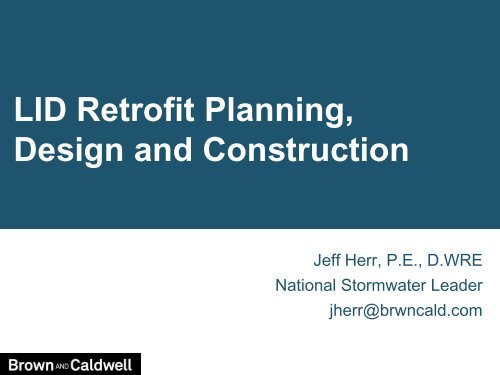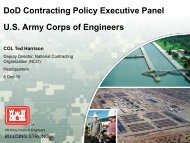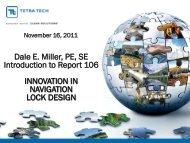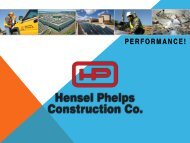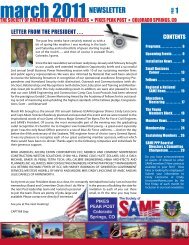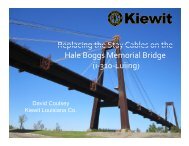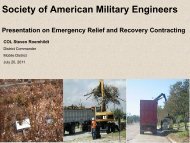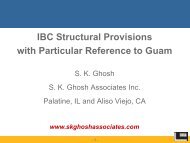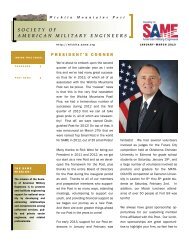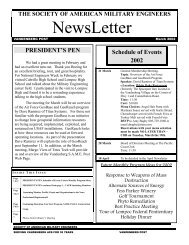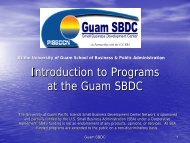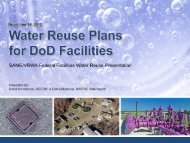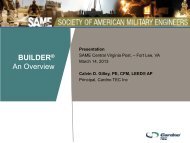Brown and Caldwell, Jeff Herr, P.E., D.WRE, Lisa Jeffrey, P.E., C.F.M
Brown and Caldwell, Jeff Herr, P.E., D.WRE, Lisa Jeffrey, P.E., C.F.M
Brown and Caldwell, Jeff Herr, P.E., D.WRE, Lisa Jeffrey, P.E., C.F.M
You also want an ePaper? Increase the reach of your titles
YUMPU automatically turns print PDFs into web optimized ePapers that Google loves.
LID Retrofit Planning,<br />
Design <strong>and</strong> Construction<br />
<strong>Jeff</strong> <strong>Herr</strong>, P.E., D.<strong>WRE</strong><br />
National Stormwater Leader<br />
jherr@brwncald.com
Underst<strong>and</strong>ing Hydrology for LID<br />
Most rainfall events are 1-inch or less<br />
Rainfall Event<br />
Range (inches)<br />
Mean Rainfall<br />
Depth (inches)<br />
Mean Rainfall Duration<br />
(hours)<br />
Fraction of Annual<br />
Rain Events<br />
Number of Annual<br />
Events in<br />
Range<br />
0.00-0.10 0.041 1.203 0.427 56.683<br />
0.11-0.20 0.152 2.393 0.142 18.866<br />
0.21-0.30 0.252 3.073 0.080 10.590<br />
0.31-0.40 0.353 3.371 0.055 7.312<br />
0.41-0.50 0.456 3.702 0.048 6.325<br />
0.51-1.00 0.713 4.379 0.129 17.102 (117)<br />
1.01-1.50 1.221 5.758 0.051 6.733<br />
1.51-2.0 1.726 7.852 0.024 3.145<br />
2.01-2.50 2.271 8.090 0.011 1.470<br />
2.51-3.00 2.704 10.675 0.006 0.726<br />
3.01-3.50 3.246 9.978 0.003 0.391<br />
3.51-4.00 3.667 13.362 0.002 0.260<br />
4.01-4.50 4.216 15.638 0.001 0.149<br />
4.51-5.00 4.796 17.482 0.000 0.056<br />
5.01-6.00 5.454 23.303 0.001 0.167<br />
6.01-7.00 6.470 40.500 0.000 0.019<br />
7.01-8.00 7.900 31.500 0.000 0.019<br />
8.01-9.00 8.190 3.500 0.000 0.019<br />
>9.00 10.675 46.250 0.001 0.075
Minimal runoff from pervious areas <strong>and</strong> N-DCIA<br />
Even in HSG ‘D’ soils – DCIA is the driver<br />
CN = 80
Up to 60% of our water use does not<br />
require potable water<br />
Using stormwater when<br />
possible is more sustainable.<br />
Saves energy, reduces GHG,<br />
saves $.
Select the Most Cost Effective BMPs<br />
ESTIMATED REMOVAL EFFICIENCIES<br />
TYPE OF BMP (% LOAD REDUCTION)<br />
TN TP TSS BOD<br />
INFILTRATION/REUSE<br />
1.00” VOLUME 80 80 80 80<br />
1.50” VOLUME 90 90 90 90<br />
WET DET (14 day WSRT) 25-35 60-70 90 50-70<br />
WET DET/FILTER 0-10 50 85 70<br />
DRY DETENTION 10-20 20-40 20-60 20-50<br />
DRY DET/FILTER (-)-20 (-)-20 40-60 0-50<br />
CHEMICAL TREATMENT 20-40 80-90 >90 30-60<br />
WETLAND TREATMENT (-)-90 (-)-90 50-90 (-)-50
Develop a Treatment Train Approach to<br />
Stormwater Management<br />
Maximize Minimize<br />
Runoff &<br />
Load<br />
Generation<br />
Regulations<br />
Public education<br />
Erosion control<br />
Roof runoff<br />
Disconnect IA<br />
L<strong>and</strong>scaping<br />
Pervious paving<br />
Pavement<br />
cleaning<br />
LID<br />
Conveyance<br />
<strong>and</strong><br />
Pretreatment<br />
Swales<br />
Catch Basins<br />
Inlets filters<br />
Oil/water separators<br />
Trash/sediment traps<br />
Additional<br />
Treatment<br />
&<br />
Attenuation<br />
Detention<br />
Wetl<strong>and</strong><br />
Storage<br />
Sediment sump<br />
Toolbox<br />
Final<br />
Treatment<br />
<strong>and</strong><br />
Attenuation<br />
Retention<br />
Detention<br />
Wetl<strong>and</strong><br />
Chemical<br />
Ozone<br />
UV<br />
Reuse<br />
End of pipe
Directly Connected Impervious Area<br />
is the major source of stormwater runoff.<br />
No opportunity for infiltration.<br />
1-inch rainfall = 0.9 inch runoff
Disconnect Impervious Areas<br />
1-inch rainfall = 0.4-inch runoff<br />
<strong>and</strong> lower costs!!
City of Portl<strong>and</strong> Green Streets Case Study<br />
Large scale application of LID in City<br />
Taggart Basin (~1,500 acres)<br />
– 100-year old combined sewer<br />
– pipe failures, basement flooding<br />
Pipe only solution: $144 million<br />
LID plus pipes: $81 million<br />
– 600 stormwater LID facilities
Portl<strong>and</strong> Green Streets Curb Extension
Portl<strong>and</strong> Green Streets Planter with Parking
LID Retrofit Benefits<br />
– Retrofit in existing areas<br />
– Treat stormwater near source<br />
– Evapotranspiration can reduce volume<br />
– Infiltration reduces volume<br />
– Traffic calming<br />
– Community amenity<br />
– Is cost effective<br />
– Can be integrated with<br />
other capital projects
LID Retrofit Key Issues<br />
Sizing<br />
– Storage volume, native soils infiltration rates, overflow, cost<br />
effectiveness, soil contamination<br />
Transportation<br />
– Vehicle safety requirements (sight distance)<br />
– Pedestrians <strong>and</strong> bikes (curb transitions, sidewalks, ADA)<br />
Utilities<br />
– Potable water lines, gas lines, depth of facilities<br />
– Relocation of meters & poles<br />
Urban forestry<br />
Maintenance<br />
– Irrigation, weeding, trash, etc.
LID Lessons Learned<br />
Involve transportation engineering staff<br />
early in design<br />
– Site visits, design review<br />
Address feasibility <strong>and</strong> costs with design<br />
alternatives<br />
– Utility relocation & depth of new soil<br />
– Parking <strong>and</strong> pedestrian access<br />
Address short-term & long-term<br />
maintenance<br />
– Planting, trash, sediment, irrigation, weeding
Gwinnett County DWR Case Study<br />
~31 acres total,<br />
18.5 acres impervious,<br />
60% impervious.<br />
Decided only the<br />
immediate site would<br />
be used for treatment;<br />
no off-site treatment.<br />
Wanted to demonstrate<br />
LID can be used for any<br />
level of imperviousness<br />
allowed by County code;<br />
residential, commercial,<br />
or industrial.
Gwinnett County DWR Project Objectives<br />
Determine if it is possible to infiltrate <strong>and</strong>/or store/reuse<br />
on-site the runoff from the 95 th percentile storm event<br />
(EISA)<br />
Determine effectiveness of different LID practices<br />
Determine construction <strong>and</strong> operation <strong>and</strong> maintenance<br />
requirements for infiltration <strong>and</strong> storage/reuse facilities<br />
Determine capital, O&M <strong>and</strong> life cycle costs for different<br />
types of LID practices<br />
Use constructed project to educate developers,<br />
engineers, <strong>and</strong> the public on the use of LID practices<br />
Promote the use of viable LID practices in Gwinnett<br />
County
Completed Project Site Drainage Sub-Basin<br />
Delineation
Developed Historical Annual Rainfall<br />
Probability Distribution for Atlanta<br />
1.73 inch event<br />
= 95 th %<br />
Total average annual rainfall = 49.6 inches.
Performed Subsurface Testing <strong>and</strong><br />
Evaluated Site Soil Types
Completed In-Situ Infiltration Testing at<br />
Proposed Bottom of Engineered Soils<br />
Measured infiltration rate = 1 to 6 inches per hour at 6-8 ft below existing grade;<br />
proposed bottom elevation of infiltration practices.
Goal to Include at Least One of Each of<br />
These LID Practices in the Design
Initially Evaluated Three Different LID BMPs<br />
per Sub-Basin<br />
Evaluated effectiveness for runoff volume reduction <strong>and</strong> cost.
Developed Three Alternative Overall Site<br />
Retrofit Plans- Alternative A
Final Preliminary Plan<br />
Met with all DWR Department Managers <strong>and</strong> incorporated comments.
Preliminary Plan LID Practices Utilized
Estimated Runoff Volumes <strong>and</strong> Load<br />
Reductions for Sub-Basins <strong>and</strong> Project Site
Moving Forward<br />
Estimated Construction Cost = $1,000,000<br />
Estimated Annual O&M cost = $90,000<br />
Submitted 319 (h) grant application to GA EPD;<br />
Requested $600,000 with $400,000 local match<br />
If grant approved, construction scheduled for late<br />
2012<br />
Post construction monitoring proposed for each type<br />
of LID practice<br />
Construction of Phase I (bioretention area <strong>and</strong> roof<br />
rainwater harvesting system) completed in July 2011<br />
using another 319 (h) grant
Phase I Construction – Completed in one<br />
month, July 2011
Pre-Construction Site Area<br />
Curb inlet for parking area<br />
Drainage area = 1 ac<br />
Imperv. area = 0.7 ac<br />
(parking area)<br />
Parking drains to one<br />
curb inlet.<br />
0.3 acre raised grass<br />
area available.
Excavation <strong>and</strong> Underdrain Installation<br />
Excavated area for engineered soils<br />
(3-4 ft) <strong>and</strong> loosened soil to a depth<br />
2 ft. below proposed bottom of<br />
engineered soils.<br />
Installed 6-inch HDPE underdrain<br />
<strong>and</strong> gravel trench with 15-inch risers.
Engineered Soils <strong>and</strong> Gravel Backfill<br />
Installed engineer soils in 1 ft lifts<br />
<strong>and</strong> watered to consolidate.<br />
Installed gravel trenches across<br />
area to aid in runoff distribution.
Backfill Completion <strong>and</strong> Final Grading<br />
Installed remaining engineered<br />
soils in 1 ft lifts <strong>and</strong> watered<br />
to consolidate.<br />
Final surface grading 3-5H:1V slopes.
Surface Treatment – Cobble, mulch, plants<br />
<strong>and</strong> sod
Completed Project<br />
3-inch tall curb<br />
around inlet;<br />
runoff overflows<br />
into curb inlet<br />
when pond is full.<br />
Underdrain <strong>and</strong><br />
risers have<br />
closed valve;<br />
Installed to be<br />
used only if pond<br />
does not infiltrate<br />
naturally.<br />
Construction<br />
cost = $100,000<br />
Primary cost was<br />
engineered soil<br />
purchase.<br />
New<br />
curb<br />
Existing<br />
Inlet<br />
New<br />
curb<br />
cuts
Completed Project<br />
Frequent watering is initially required<br />
due to s<strong>and</strong>y soils.<br />
Installed a 6,000 gallon tank next to<br />
building <strong>and</strong> roof rainwater harvesting<br />
system in September for watering<br />
bioretention.<br />
(1-inch rain = 1,000 gallons of water)
BMP Life Cycle Cost Comparison<br />
Retrofit<br />
BMP<br />
Life Cycle Cost per<br />
kg TP removed<br />
($)<br />
Life Cycle Cost per<br />
kg TN removed<br />
($)<br />
Pet Waste Education 150 - 300 20 - 40<br />
Second Generation Baffle Box 800 – 1,600 250 - 500<br />
Wet Detention Pond 1,200 - 2,400 500 - 1,000<br />
Dry Detention Basin 3,500 - 7,000 1,250 - 2,500<br />
LID - Bioretention 20,000 - 40,000 2,500 - 5,000<br />
Stream Restoration 2,000 - 4,000 300 - 600<br />
Chemical Treatment 90 - 180 50 - 100<br />
Enhanced Wetl<strong>and</strong> Treatment 100 - 200 100 - 200<br />
Education is very cost effective.<br />
Larger - regional systems tend to have significantly lower life cycle<br />
costs per mass of TP <strong>and</strong> TN removed than many smaller systems.
LID Planning at Federal Facilities<br />
in the Chesapeake Bay<br />
Watershed<br />
November 3, 2011<br />
<strong>Lisa</strong> <strong>Jeff</strong>rey, PE, <strong>Brown</strong> <strong>and</strong> <strong>Caldwell</strong>
Site Assessment Pilot Projects<br />
NAVFAC Mid-Atlantic & NAVFAC Washington<br />
Identify stormwater improvement options<br />
Prioritize sites<br />
Conceptual designs <strong>and</strong> cost estimates for top<br />
ranked projects<br />
Establish implementation plan for regulatory<br />
compliance – 25 year CIP
Regional Stormwater Improvement Plan<br />
4<br />
1. Project Initiation (Kickoff)<br />
2. Compile Information<br />
3. Characterize Existing Conditions<br />
STEPS<br />
4. Determine Stormwater Compliance Approach<br />
2011
Regional Stormwater Improvement Plan<br />
Physical<br />
Conditions<br />
Conveyance<br />
Infrastructure<br />
T3A – Characterize installation physical<br />
conditions<br />
Draft<br />
TM 3A – 3B<br />
Compile soil types, groundwater, l<strong>and</strong> use/cover,<br />
buildings, impervious area, imagery data in GIS<br />
T3B – Characterize existing infrastructure<br />
Compile GIS, CAD & BMP data for stormwater<br />
infrastructure mapping<br />
Tabulate structure & pipe location, material, size,<br />
elevation & other available data<br />
Review<br />
Meeting<br />
Final<br />
TM 3A – 3B<br />
GIS Data Needs: terrain, imagery,<br />
l<strong>and</strong> use/cover, structures &<br />
improvements, development<br />
timeframes, impervious layer, soil &<br />
groundwater data, CA boundaries,<br />
SW infrastructure, connected<br />
rooftops, existing BMPs,& CAD files<br />
2011
Regional Stormwater Improvement Plan<br />
Final<br />
TM 3A – 3B<br />
Task 3C Hydrologic & SW Management<br />
Summary<br />
– Hydrology Summary<br />
Drainage basins delineated based on contours <strong>and</strong><br />
accurate stormwater conveyance system information<br />
(inlets, outlets, etc)<br />
– Existing SWM BMPs<br />
TM 3C –<br />
Delineate DAs<br />
Delineate drainage areas around each BMP<br />
TM 3C –<br />
Delineate BMPs<br />
Tabulate the areas receiving water quality treatment<br />
versus untreated impervious area – to form the basis<br />
of retrofit analysis<br />
Review Meeting Final<br />
TM 3C<br />
GIS Data Needs:<br />
• Topography<br />
• Accurate stormwater<br />
conveyance system information<br />
• Existing BMP locations, types,<br />
drainage areas<br />
2011
Regional Stormwater Planning:<br />
Cheatham Annex/Yorktown Fuels<br />
Site Description:<br />
– Cheatham Annex - 1,570 acres<br />
– Yorktown Fuels - 110 acres<br />
Cheatham Annex - Less than<br />
50% developed, primarily<br />
warehouse storage <strong>and</strong> forest<br />
Yorktown Fuels maintained as<br />
turf grass, forest on perimeter -<br />
less than 15% impervious
Regional Stormwater Planning :<br />
Cheatham Annex/Yorktown Fuels<br />
Preliminary Site<br />
Assessments<br />
– Storm system maps<br />
– Facility plans<br />
– Outfall reports<br />
– GIS data layers (i.e.<br />
cultural resources)
Regional Stormwater Planning :<br />
Cheatham Annex/Yorktown Fuels<br />
Alternative Analysis<br />
– Location<br />
– Drainage area<br />
– L<strong>and</strong> use type<br />
– Potential improvement measures for the site<br />
– Sketch of site <strong>and</strong> potential BMPs<br />
– Utilities<br />
– Observed problems
Chesapeake Environmental Benefit<br />
BMP Efficiencies<br />
Urban BMP<br />
Total<br />
Nitrogen<br />
Load Reduction (%)<br />
Total<br />
Phosphorus TSS<br />
Wet Ponds, Constructed Wetl<strong>and</strong>s 20 45 60<br />
Dry Detention/Hydrodynamic 5 10 10<br />
Dry Extended Detention Pond 20 20 60<br />
Infiltration, A/B soils 80 85 95<br />
Filters (s<strong>and</strong>/organic/peat) 40 60 80<br />
Bioretention<br />
Permeable<br />
Pavement<br />
C&D w/ UD 25 45 55<br />
A&B w/ UD 70 75 80<br />
A&B w/o UD 80 85 90<br />
C&D w/ UD 10 20 55<br />
A&B w/ UD 45 50 70<br />
A&B w/o UD 75 80 85<br />
Grass Channels<br />
C&D w/o UD<br />
A&B w/o UD<br />
10<br />
45<br />
10<br />
45<br />
50<br />
70<br />
Bioswale 70 75 80
Regional Stormwater Planning :<br />
Cheatham Annex/Yorktown Fuels
Proposed Bioswale Improvement
Infiltration Practices: Bioswales
Rooftop Drainage BMPs<br />
Source: CWP<br />
Infiltration 80%N; 85%P; 95%TSS
Stormwater Storage <strong>and</strong> Reuse
Infiltration Practices: Permeable Pavers <strong>and</strong><br />
Porous Pavement
Parking Lot Retrofit<br />
Retrofit Options:<br />
Bioretention Isl<strong>and</strong>s<br />
Permeable Pavers<br />
Grass Swales<br />
S<strong>and</strong> Filter<br />
Filter Strip/Infilt.Trench<br />
Source: CWP
:Regional Stormwater Planning :<br />
Cheatham Annex/Yorktown Fuels
Erosion Impacting Storm Drainage
Erosion within drainage system
Design of Natural Stream Restoration<br />
<strong>and</strong> Erosion Control BMPs<br />
Stream Restoration <strong>and</strong><br />
Erosion Control Options
Summary<br />
NAVFAC Stormwater/LID Planning Projects<br />
–Identify stormwater improvement alternatives<br />
–Prioritize alternatives<br />
–Establish plan for improvements required to<br />
meet load reductions<br />
Chesapeake Bay TMDL<br />
–Identify Potential for trading within<br />
Watershed<br />
–Develop facility load reduction compliance<br />
plan


